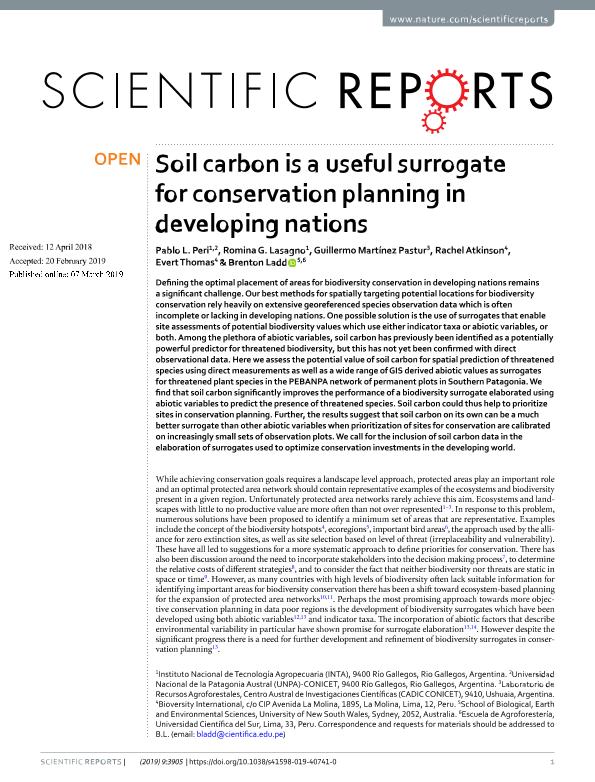Mostrar el registro sencillo del ítem
dc.contributor.author
Peri, Pablo Luis

dc.contributor.author
Lasagno, Romina G.
dc.contributor.author
Martínez Pastur, Guillermo José

dc.contributor.author
Atkinson, Rachel
dc.contributor.author
Thomas, Evert
dc.contributor.author
Ladd, Brenton
dc.date.available
2020-11-13T13:36:13Z
dc.date.issued
2019-03
dc.identifier.citation
Peri, Pablo Luis; Lasagno, Romina G.; Martínez Pastur, Guillermo José; Atkinson, Rachel; Thomas, Evert; et al.; Soil carbon is a useful surrogate for conservation planning in developing nations; Nature Publishing Group; Scientific Reports; 9; 1; 3-2019; 1-6
dc.identifier.issn
2045-2322
dc.identifier.uri
http://hdl.handle.net/11336/118319
dc.description.abstract
Defining the optimal placement of areas for biodiversity conservation in developing nations remains a significant challenge. Our best methods for spatially targeting potential locations for biodiversity conservation rely heavily on extensive georeferenced species observation data which is often incomplete or lacking in developing nations. One possible solution is the use of surrogates that enable site assessments of potential biodiversity values which use either indicator taxa or abiotic variables, or both. Among the plethora of abiotic variables, soil carbon has previously been identified as a potentially powerful predictor for threatened biodiversity, but this has not yet been confirmed with direct observational data. Here we assess the potential value of soil carbon for spatial prediction of threatened species using direct measurements as well as a wide range of GIS derived abiotic values as surrogates for threatened plant species in the PEBANPA network of permanent plots in Southern Patagonia. We find that soil carbon significantly improves the performance of a biodiversity surrogate elaborated using abiotic variables to predict the presence of threatened species. Soil carbon could thus help to prioritize sites in conservation planning. Further, the results suggest that soil carbon on its own can be a much better surrogate than other abiotic variables when prioritization of sites for conservation are calibrated on increasingly small sets of observation plots. We call for the inclusion of soil carbon data in the elaboration of surrogates used to optimize conservation investments in the developing world.
dc.format
application/pdf
dc.language.iso
eng
dc.publisher
Nature Publishing Group

dc.rights
info:eu-repo/semantics/openAccess
dc.rights.uri
https://creativecommons.org/licenses/by/2.5/ar/
dc.subject
soil carbon
dc.subject
grasslands
dc.subject
conservation
dc.subject
threatened biodiversity
dc.subject.classification
Conservación de la Biodiversidad

dc.subject.classification
Ciencias Biológicas

dc.subject.classification
CIENCIAS NATURALES Y EXACTAS

dc.title
Soil carbon is a useful surrogate for conservation planning in developing nations
dc.type
info:eu-repo/semantics/article
dc.type
info:ar-repo/semantics/artículo
dc.type
info:eu-repo/semantics/publishedVersion
dc.date.updated
2020-11-11T18:59:19Z
dc.journal.volume
9
dc.journal.number
1
dc.journal.pagination
1-6
dc.journal.pais
Reino Unido

dc.description.fil
Fil: Peri, Pablo Luis. Instituto Nacional de Tecnología Agropecuaria; Argentina. Universidad Nacional de la Patagonia Austral; Argentina. Consejo Nacional de Investigaciones Científicas y Técnicas; Argentina
dc.description.fil
Fil: Lasagno, Romina G.. Instituto Nacional de Tecnología Agropecuaria; Argentina
dc.description.fil
Fil: Martínez Pastur, Guillermo José. Consejo Nacional de Investigaciones Científicas y Técnicas. Centro Austral de Investigaciones Científicas; Argentina
dc.description.fil
Fil: Atkinson, Rachel. No especifíca;
dc.description.fil
Fil: Thomas, Evert. No especifíca;
dc.description.fil
Fil: Ladd, Brenton. University of New South Wales; Australia. Universidad Científca del Sur; Perú
dc.journal.title
Scientific Reports
dc.relation.alternativeid
info:eu-repo/semantics/altIdentifier/doi/https://doi.org/10.1038/s41598-019-40741-0
Archivos asociados
